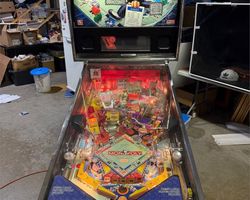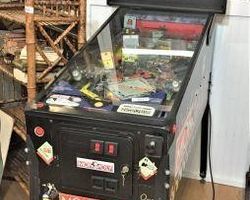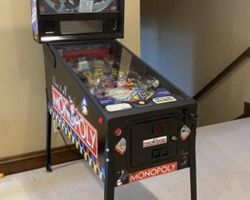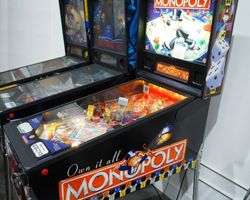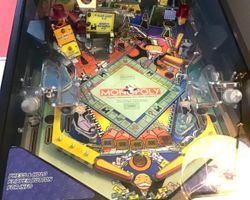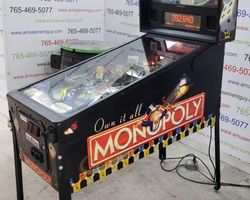Monopoly™

Average Prices: USD $1,600 to $3,600
Produced: September, 2001
Production Run: 3,640 units
Machine Type: Solid State Electronic
MPU: Sega/Stern Whitestar
Players: 4
Design by: Pat Lawlor
Art by: John Youssi
Dots/Animation by: Kurt Andersen
Mechanics by: John Krutsch
Music by: Chris Granner
Sound by: Chris Granner
Software by: Louis Koziarz, Greg Dunlap
Stern Pinball's 2001 release, Monopoly, translates the experience of the classic Parker Brothers board game into a kinetic world of ramps, targets, and silver ball action. Bringing together a team experienced in pinball design and leveraging a universally recognized theme, Monopoly aimed to capture both the strategic accumulation of the board game and the fast-paced excitement of pinball.
History and Background
Manufactured by Stern Pinball, Inc. and released in September 2001, Monopoly pinball machine entered the market during a transitional period for the company, then recently rebranded from Sega Pinball. The machine operates on the Sega/Stern Whitestar system, a platform shared with several other titles from that era. The choice of the Monopoly theme provided instant recognition, drawing inspiration directly from the ubiquitous board game about real estate acquisition and financial dominance.
The design was spearheaded by Pat Lawlor, whose name is associated with numerous pinball titles. Lawlor worked alongside a team including John Krutsch handling mechanics. The visual identity of the game was crafted by artists John Youssi and Kurt Andersen, who adapted the familiar Monopoly iconography—from Mr. Monopoly (Rich Uncle Pennybags) to property deeds and game tokens—for the pinball cabinet, backglass, and playfield. Kurt Andersen also contributed animations for the Dot Matrix Display (DMD). The auditory experience, encompassing music and sound effects, was composed by Chris Granner, while the software and ruleset were developed by Greg Dunlap and Louis Koziarz.
Approximately 3,640 units of Monopoly were produced. This figure includes a special, limited 'Platinum Edition' variant. Only 40 of these Platinum Editions were made, corresponding to the 40 spaces on the Monopoly board. These exclusive units featured chrome trim and were signed by Pat Lawlor, John Youssi, and Gary Stern.
An interesting piece of trivia involves a regional variation: some European versions of the game featured Mr. Monopoly's head as the center post ball save, activated by a secondary set of flipper buttons. The game was marketed with slogans like "Own It All!™" and "Be a Tycoon!™", directly linking the pinball experience back to the board game's objective.
Signature Features and Design
Monopoly integrates several distinct mechanisms and design choices that define its character. Perhaps the most discussed feature is the small, constantly rotating, bi-directional mini-flipper positioned above the 'Water Works' saucer. This "flipper" acts primarily as a moving guard, making the saucer shot deliberately challenging. When a player successfully lands the ball in the Water Works saucer, the rotating element then actively clears the ball, adding a unique mechanical interaction not commonly found in other machines.
Another prominent feature is the large Bank Vault door located centrally on the playfield. This toy is more than just decorative; it incorporates hit detection and physically swings open horizontally at specific points during gameplay. Revealing the entrance to a hidden ramp shot behind it, the Bank door serves as a dynamic physical obstacle and a gateway to progression.
Beyond the main DMD used for scoring and game information, Monopoly features a smaller, secondary dot matrix display situated above the Electric Company ramp entrance. During the game's attract mode, this display cycles through over 100 different quotes, adding an extra layer of thematic detail and visual interest even when the machine is idle. The overall design successfully translates the colorful and recognizable Monopoly board aesthetic into a three-dimensional, interactive environment.
Playfield and Mechanics
The Monopoly playfield is densely packed with shots and features, reflecting Pat Lawlor's design approach often characterized by numerous intersecting paths and distinct playfield toys. The layout includes four ramps, six pop bumpers providing chaotic action in the upper playfield, a single bank of drop targets, and spinners. Player control is managed via three standard flippers—two in the traditional lower position and one upper right flipper facilitating shots towards the left side of the playfield and upper loops. The unique rotating mini-flipper adds another layer of interaction distinct from standard flipper control.
Major shots include the left and right ramps, the Railroad ramp (often a key shot for progression), and the ramp hidden behind the Bank Vault door. The Water Works saucer, guarded by the rotating mini-flipper, presents a specific challenge, while the Electric Company shot utilizes the ramp leading past the secondary mini-display. The layout demands precision, with tight shots interspersed among more open ramp entries.
The playfield artwork, by Youssi and Andersen, heavily features Monopoly staples: property spaces line the major shots and orbits, Chance and Community Chest locations are represented, and Mr. Monopoly himself is prominently displayed, particularly near the main flippers amidst piles of money. The lighting design works to highlight active shots and modes, guiding the player through the objectives while enhancing the vibrant, board-game-inspired aesthetic. The overall design philosophy aims to immerse the player in the Monopoly world, linking physical shots to thematic goals like property acquisition and railroad monopolies.
Gameplay Dynamics
Monopoly's gameplay structure mirrors the board game's core concepts. Players progress by making shots corresponding to landing on properties, collecting railroads, and activating features tied to Chance and Community Chest cards. Dice rolls, simulated through gameplay actions or random awards, often influence progression around a virtual representation of the board.
The ruleset encourages players to acquire properties by hitting associated shots repeatedly. Completing property groups (color sets) lights features or starts modes, increasing scoring potential. The Railroad ramp is crucial for building towards Railroad Multiball, while the Bank Vault door must often be hit or opened to access specific modes or objectives.
The game features several distinct modes, often initiated via the Chance or Community Chest scoops, offering varied tasks and scoring opportunities. Multiball play is a significant component, with the primary mode being a 4-ball multiball, offering high-scoring potential and frantic action. Strategic play involves balancing property acquisition with mode completion and capitalizing on multiball opportunities. The ultimate goal for skilled players is to reach the "Land Grab" wizard mode, a challenging culmination of the game's main objectives.
Gameplay highlights often involve successfully navigating the challenging Water Works shot past the rotating flipper, timing shots to open the Bank Vault, or achieving a lucrative Railroad Multiball. While some shots, like the left ramp, can be repetitive if focused on exclusively, mastering the entire playfield and understanding the interplay between property collection, modes, and multiball is key to high scores. The integration of custom speech and sound effects by Chris Granner further reinforces the theme, with callouts related to Monopoly actions and characters.
Reception and Legacy
Upon release and throughout the years, Stern's Monopoly has garnered a generally positive reception within the pinball community, though it remains a somewhat polarizing title. Many players praise its successful and creative integration of the Monopoly theme, finding the way properties, railroads, Chance, and Community Chest elements are woven into the pinball ruleset to be engaging and intuitive. The gameplay is frequently described as fun, fast-paced, and addictive, with satisfying shot feedback, particularly on the ramps.
The unique layout and signature features, especially the rotating mini-flipper and the interactive Bank Vault door, are often cited as highlights that give the machine a distinct personality. The artwork and sound package are generally well-regarded, capturing the familiar Monopoly feel effectively. Its relatively straightforward primary objectives combined with deeper modes make it approachable for casual players while offering challenges for seasoned enthusiasts, contributing to its reputation as a family-friendly machine.
However, criticisms exist. Some players find the playfield layout overly crowded or cramped, occasionally leading to ball visibility issues. The placement and behavior of the rotating mini-flipper, while unique, is disliked by some players who find it obstructive or unpredictable. Repetitiveness can be a concern, with some strategies potentially over-reliant on repeatedly hitting specific shots like the left ramp. While the theme integration is lauded by many, others find the Monopoly theme itself uninspired for a pinball machine. Compared to more complex rulesets found in later pinball machines, some find Monopoly's depth slightly lacking. Durability concerns have also been noted, with potential for playfield wear in high-traffic areas and the need for periodic maintenance on mechanisms like the bank door and rotating flipper.
Monopoly holds its place as a recognizable and often sought-after Stern title from the early 2000s. It stands as a testament to Pat Lawlor's design ingenuity and a successful execution of translating a board game into a compelling pinball experience. While perhaps not universally hailed as a top-tier collectible by all, its unique features, strong theme integration, and engaging gameplay ensure its continued presence and playability in arcades and home collections.
 Active Auctions
Active Auctions
 Auction Results
Auction Results
| Cost | Location | Date |
|---|---|---|
| USD $3,250 |  Wisconsin, United States Wisconsin, United States |
23 March, 2025 |
| USD $3,300 |  California, United States California, United States |
27 January, 2025 |
| USD $4,995 |  California, United States California, United States |
29 December, 2024 |
| USD $5,889 |  Florida, United States Florida, United States |
24 September, 2024 |
| USD $3,700 |  Ohio, United States Ohio, United States |
11 June, 2024 |
| USD $4,175 |  Indiana, United States Indiana, United States |
03 June, 2024 |
| USD $4,175 |  Indiana, United States Indiana, United States |
01 June, 2024 |
| USD $5,200 |  Minnesota, United States Minnesota, United States |
30 March, 2024 |
| USD $4,550 |  United States United States |
24 March, 2024 |
| USD $6,300 |  United States United States |
13 March, 2024 |


Private Policy · Search Website · Contact Us
All trademarks and copyrighted materials remain property of their respective owners.
All other content copyright 2007 - 2025 Pinpedia.

